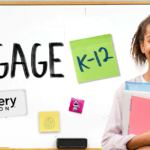Remote Learning Tools Are Key Components of the Kentucky Valley Educational Cooperative’s Initiatives to Address Equity and Access
By Dessie Bowling, Robert Brown and Jeff Hawkins
The Kentucky Valley Educational Cooperative (KVEC) is a non-profit 501c3 educational service agency established in 1969 by 8 small school districts. Today, we serve more than 55,000 students and 3,000 educators within our 23-member districts in rural eastern Kentucky. These districts are in some of the most distressed counties in America in terms of poverty, education, and employment.
This graphic identifies the economic status of counties according to the Appalachian Regional Commission (ARC) metrics.
All counties in KVEC’s membership are designated as distressed
The Fifth Congressional District is home to 22 of KVEC’s districts and ranks as the third-highest United States congressional district for percentage of population at or below the poverty threshold, according to the Food Research and Action Center data analysis of 2017.
The region has long been dependent on a mono-economy driven by the coal industry. The decline in coal production has led to unemployment and population loss. The regional Workforce Investment Board serves all KVEC districts; they noted 34,539 fewer people working from June 2012 to September 2018 and lost 47,421 people from the labor force in the 23-county area. Kentucky as a whole saw an increase of 84,935 people working and added 80,117 to its labor force during this same timeframe (Kentucky Center for Statistics, 2012-2018).
The state population increased by 10.2% during this time, while county populations in the KVEC service area decreased by 11.4%. Unfortunately, current population loss trends are expected to result in a reduction in representation for our region in the State Legislature following the 2020 census report.
Rural communities need equitable representation so that Americans have their voices heard
Districts in the KVEC region are high poverty, low income, rural and remote, according to Federal Department of Education Guidelines. Although the average free and reduced lunch participation rate for the KVEC region is 73.5%, not all students eligible to participate for multiple reasons (i.e., parental permissions, social stigma, etc.). Based on 2018-19 School and Community Nutrition Qualifying Data (school-by-school count), the free and reduced lunch qualifying average for the region is 96.4%.
Despite the grim statistics, our K-12 public schools have documented growth over the past four years. Collectively, they have a higher College and Career Readiness level than the state average (KVEC region = 72.5%, KY = 66%) and a higher graduation rate (KVEC region = 94.4, KY = 89.7) as noted on KDE school report cards.
While most of the state has emerged from the deep recession of a decade ago, the recovery has remained elusive for our rural communities. The decreasing state revenue in real dollars generated means an increasing attempt to offset this loss through local funding. However, in an area where coal mines remain closed and families have relocated to find work, local dollars are not adequate to keep pace.
The funding gap between the haves and have-nots is growing. The amount of lost revenue resulting from combating COVID-19 remains to be seen, but it will surely have a negative impact on school funding.
The challenges facing children of poverty and those who serve them are real, but not impossible to overcome. As we tackle the challenges from the COVID-19 pandemic, we must continue providing exceptional learning experiences for all our K-12 students to ensure they aren’t left behind.
In normal times, KVEC staff and educators would have a focused effort on the annual FIRE Summit (Forging Innovation in Rural Education), and other professional learning summits designed to uplift and celebrate the innovative work of educators and students. These are not normal times.
In March, the COVID-19 pandemic forced schools to reimagine teaching and learning
It also caused educators to re-envision how best to deliver instruction whether via paper packets or distance learning. At KVEC, we continue providing support and resources, delivered to the greatest degree possible, in a virtual environment via distance technology.
Schools in our region have been working for several years to build an effective digital environment for teaching, learning and leading. Kentucky was the first state in the country with internet connections in every school district; and, the Kentucky Department of Education continued to expand their educational technology initiatives becoming the first state to provide 100 kilobytes of fibered internet access per student in 2015.
East Kentucky schools led the way in achieving 100% digital connectivity for every learner in schools across the region. At school, students have access to a robust and reliable technology system through the Kentucky Educational Technology System. However, the region’s rugged terrain and sparse population distribution impacts widespread availability to high-speed internet connectivity (due to profitability for providers and affordability for consumers) and the schools’ universal connectivity is not shared across our rural communities.
Since 2011, access to a wired connection of at least 10mbps has improved from 79.9% to 96.3% of Kentuckians. While that is good, 257,000 homes (primarily in KVEC’s rural service area) are without access to a wired connection capable of 25mbps download speeds and another 142,000 homes (again, primarily in KVEC’s service area) are not served by any internet provider (Cooper, T., 2020, February 06).
Residents in the KVEC region must budget their financial resources
High levels of unemployment and a high percentage of people dependent on government transfer payments cause families to make difficult financial choices. Internet connectivity is often left out of a family’s budget, making student engagement and completion of learning goals via distance learning challenging at best.
KVEC supported schools in the move toward a 1:1 learning environment, developed the www.theholler.org into a multi-component, place-based social learning platform, invested in digital badging, micro-credentials, online learning, and digital connectivity. We have a highly skilled staff capable of adapting quickly and innovating by necessity.
When Kentucky closed school buildings to students on March 16th, many people believed the move toward virtual learning would be short-term and that students would be back in their classrooms by April first. As we learned more, our leadership team recognized that schools may not reopen for students by April first and the need for virtual learning could extend well beyond.
Enter Digitalachia
Our team consistently takes a proactive approach to facing challenges and did so in this case by generating solutions to get out in front of the COVID-19 pandemic and put supports in place to address immediate and long-term needs. Out of that work, Digitalachia was developed to inspire creativity and enable educators to network in real-time and share professional learning experiences.
Through KVEC’s learning platform, a collection of free resources and online professional development tools are available to aid in virtual learning and teaching. In addition, KVEC staff remain available for enhanced Zoom meetings and Twitter chats with educators to assist and support. Below are resources located at www.digitalachia.com for educators and parents providing instruction for students in the nontraditional way.
- Video Production filming tips and free screen-casting resources to help teachers create, and upload on-line lessons using Google Forms and Autocrat.
- DIY STEM Videos – Are you stuck at home? Are you yearning to build something with your hands? The Holler Boyz have the videos for you.
- Open Education Resources (content, grade level) – Online Teaching & Learning Resources for NTI.
- A Virtual FIRE Summit that will enable more than 230 regional educators and school teams to demonstrate their innovative solutions to a broad audience –May, 2020.
- A National Micro- Credential Virtual Summit that will enable presenters and participants to learn from and with national thought leaders and practitioners –June, 2020.
- Special Education Spring Conference converted to an on-line framework available to all participants anywhere/anytime –May, 2020.
- Expanded Zoom meetings and Twitter chats with leadership, educators and students.
The Futuring Team
The COVID-19 pandemic underscores the importance of an equitable, digital teaching and learning environment. To answer this and other challenges facing our rural communities, KVEC created a Futuring Team. KVEC leadership, superintendents and other school leaders are looking ahead to challenges around the next curve in the road. It is essential that our rural school communities create a framework to predict and prevent rather than react and repair.
Goals for the Futuring Team concentrate on 4 broad categories driven by critical questions:
Public Education
- How can the current situation lead (or even accelerate) a transformation in public education that results in a more effective structure better adapted to personalized learning, access, opportunity and equity?
- Is it possible to create a highly functioning, hybrid system of public education that improves the current system? This could be inclusive of investigating alternative school calendars interlacing face-to-face sessions with virtual at home instruction including technical education in blended models.
- Acknowledge that technology is part of the solution but is not the only necessary component of the solution. Many homes do not have the luxury of multiple technological devices that can be shared across grade spans.
Community
- How do we begin a discussion with districts, caregivers, businesses, religious leaders, and other community members that a new system is needed not only for this current COVID-19 situation but to ultimately be ready for the next big thing?
- What technology do non-education agencies have that can be shared freely among schools/districts and vice versa?
- What processes do we currently have in place to demonstrate that public schools provide a level of physical, mental and emotional health services to students? Can these be provided through a digital platform?
Work/Employment
- What will future work look like and where will this work take place (home, telework, etc.)?
- How do we do “hands-on” work – being makers of things, growing food, delivering, fixing things, electricity, plumbing?
- How do we ensure stable and accessible Health Care/Mental Health/Safety systems?
- What jobs will emerge, and which ones will decrease?
Governance and Infrastructure
- Revenue and Resources
- Continuation of safety net structures
- Brick and mortar structures as cornerstones
- Access to Government
- Access to Democratic Process
- Universal Access to Broadband – How to advocate? How to provide information to the public(s) so there is equity no matter the zip code, no matter the socio-economic level?
These and other considerations will expand the work within Digitalachia and drive the Futuring Team’s evolving agenda. KVEC has experience in developing and implementing remote learning models to assist equitable access to learning resources for rural students. Building on and creating new structures and partnerships will enable a model to be developed to better address the current COVID-19 pandemic and other challenges that will emerge.
We believe this will be a transportable model that could be used in other rural areas to begin the conversation of equity in education across our nation.
Resources found at Digitalachia.com and on theholler.org are available for educators and students at no cost. To learn more, check out our website and feel free to ‘holler’ at us anytime.
Contributing to this article:
- Dr. Dessie Bowling, Associate Director Dessie.bowling@hazard.kyschools.us
- Robert Brown, Lead Policy Analyst Robert.brown@hazard.kyschools.us
- Dr. Jeff Hawkins, Executive Director Jeff.hawkins@hazard.kyschools.us
The American Consortium for Equity in Education, publisher of the "Equity & Access" journal, celebrates and connects the educators, associations, community partners and industry leaders who are working to solve problems and create a more equitable environment for historically underserved pre K-12 students throughout the United States.
- American Consortium for Equity in Educationhttps://ace-ed.org/author/admin/
- American Consortium for Equity in Educationhttps://ace-ed.org/author/admin/April 23, 2025
- American Consortium for Equity in Educationhttps://ace-ed.org/author/admin/
- American Consortium for Equity in Educationhttps://ace-ed.org/author/admin/







